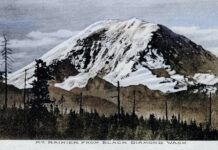The year 1911 was a significant one in the history of early attempts to tame the Cedar, Green, and White Rivers for water supplies and hydroelectric power. The City of Tacoma, facing periodic outbreaks of typhoid from contaminated water, began construction of a water pipeline from the upper Green River several miles east of Kanaskat. However, rainstorms destroyed initial work as seen in this November 1911 photo. That same monsoon wreaked havoc in the Cedar River when Seattle’s Landsburg diversion dam failed leading to the flooding of downtown Renton. Tacoma’s work on their wooden Pipeline No. 1 continued as a gravity line, which crossed through Cumberland, Enumclaw, Buckley then south to McMillin before turning northwest to the ‘City of Destiny.’ With an improved water supply and the installation of additional chlorination plants, Tacoma’s water quality improved as typhoid deaths dropped from 12.5 per 100,000 residents in 1913 to 2.1 in 1919.
This photo looking downstream near the lower Green River Headworks Road comes courtesy of JoAnne Matsumura, an Issaquah historian with additional information from Bryan King, the longtime Watershed Manager for Tacoma Water.






